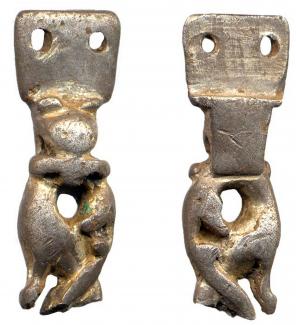Late Anglo-Saxon three-dimensional finial/strap-end, broken at one end, 10th century AD, found by metal detector at Warnford, Hampshire. In from a sub-rectangular plate with two fixing holes depends a small rounded animal head which bites into the top of the head of a backward-looking canine creature, which in turns appears to bite another ill-defined creature attacking its rump. The tail of another creature is visible at the broken end of the piece. The finial/strap-end is in the so-called Winchester style.
Silver-gilt strap end fitting
Anglo-Saxon, 10th century AD
Found by a metal detectorist at Warnford, Hampshire in 2005
This small decorative item from the end of a strap is now incomplete, but it is still possible to make out a busy three-dimensional animal design in the Late Anglo-Saxon Winchester style of art. In from the rectangular plate with its fixing holes are several entwined beasts. A canine creature, perhaps a wolf, appears to be biting at the head of another creature whilst at the same time attacking its rump. Only small traces of gilding now remain.



